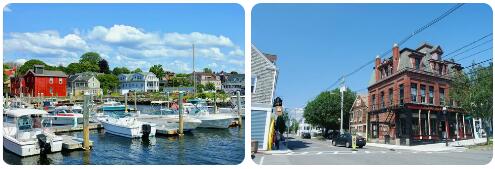
Bristol County, Rhode Island, is a small county located in the southeastern corner of the state. It is bordered by Massachusetts to the west and Connecticut to the east. The county seat is Town of Bristol, which has been an important port since colonial times. The county encompasses a total area of just over 50 square miles and has a population of approximately 49,000 people.
The landscape of Bristol County is diverse, ranging from rural plains to rolling hills and coastal areas. Much of the county consists of flat farmland that was once used for agricultural purposes. Today, much of this land has been converted into residential developments or other types of commercial development. In addition to this, there are some small towns in the area that still maintain their traditional charm and character.
The climate in Bristol County is temperate with warm summers and cold winters. Precipitation occurs throughout the year with snowfall occurring during winter months and rain during spring and summer months. The average temperature range in Bristol County ranges from 0 degrees Fahrenheit in winter months to 75 degrees Fahrenheit in summer months.
Bristol County is home to several historical sites including Colt State Park, which is listed on the National Register of Historic Places as well as Blithewold Mansion & Gardens which are open for tours throughout the year. Additionally, there are numerous museums located throughout the county including Roger Williams University’s Haffenreffer Museum of Anthropology as well as Herreshoff Marine Museum & America’s Cup Hall Of Fame located in Bristol Harbor.
Bristol County also offers many recreational activities for residents and visitors alike such as fishing at Colt State Park or boating on Mount Hope Bay or Narragansett Bay. There are also numerous golf courses located throughout the county including Green Valley Country Club or Valley Country Club which offer stunning views overlooking Narragansett Bay and provide challenging courses for golfers at all levels.
In addition to these activities, Bristol County offers a variety of shopping options from small boutiques located throughout town centers to larger malls such as East Bay Shopping Center or Providence Place Mall located nearby in Providence, Rhode Island’s capital city. For those looking for nightlife options can find them at one of several bars or clubs located around town such as The Met Café & Lounge or White Horse Tavern both offering live music performances throughout the year along with delicious food menus featuring local seafood dishes like clam cakes or fish & chips made with fresh seafood caught off local waters by local fisherman daily!
Overall, Bristol County provides its residents with an ideal blend between rural charm combined with modern amenities making it a great place to call home.
History of Bristol County, Rhode Island
Bristol County, Rhode Island is located in the southeastern corner of the state and is part of the Providence metropolitan area. It was originally inhabited by the Wampanoag tribe and was part of a larger area known as Sowams. The area was first explored by Europeans in 1614, when an expedition led by Adriaen Block landed in present-day Bristol County.
In 1637, Plymouth Colony purchased Sowams from the Wampanoags and renamed it Rehoboth. This same year, Samuel Wilbore, a settler from Massachusetts Bay Colony, established a trading post on Mount Hope Bay in what is now Bristol County. Wilbore’s trading post quickly became an important port for trade between Massachusetts Bay Colony and Rhode Island.
In 1645, Rehoboth was officially incorporated as part of Plymouth Colony and renamed Bristol County after Bristol, England. The county was divided into three townships: Barrington (now Barrington), Warren (now Warren), and Bristol (now Bristol). In 1680, King Charles II granted Rhode Island a royal charter which included all of what is now Rhode Island including Bristol County.
Bristol County began to flourish during the 18th century with its maritime industry becoming increasingly important to its economy. By 1790, it was one of the most populous counties in Rhode Island with nearly 8,000 residents living within its boundaries. During this time period there were many shipyards located throughout the county building whaling ships for merchants and fishermen alike.
The War of 1812 saw several naval battles fought off the coast of Bristol County which helped solidify its importance as a major port town in New England. In addition to naval battles during this war period there were also several skirmishes fought between British troops and local militiamen at various locations throughout the county including Fort Barton near Warren and Fort Church near Barrington.
The 19th century saw further growth for Bristol County with its population increasing steadily from just over 9,000 residents in 1800 to nearly 34,000 by 1900. During this time period many new industries moved into the area including cotton mills and factories that helped to drive economic growth throughout the region. Additionally, transportation infrastructure such as railroads were built that connected towns throughout the county making it easier for people to travel between them quickly and easily.
Today, Bristol County remains an important part of Rhode Island’s economy due to its many businesses ranging from maritime activities to manufacturing as well as tourism attractions like Blithewold Mansion & Gardens that draw visitors from across New England each year seasonally each summer seasonally annually every year. Its rich history culture & sights make it one of most popular destinations among tourists looking explore New England’s past present future alike seasonally each summer seasonally annually every year.